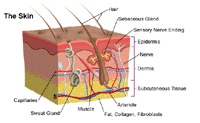Nonmelanoma Skin Cancer: Introduction
Nonmelanoma Skin Cancer: Introduction
What is cancer?
Cancer is when cells in the body change and grow out of control. To help you understand what happens when you have cancer, let’s look at how your body works normally. Your body is made up of tiny building blocks called cells. Normal cells grow when your body needs them, and die when your body does not need them any longer.
Cancer is made up of abnormal cells that grow even though your body doesn’t need them. In most cancers, the abnormal cells grow to form a lump or mass called a tumor. If cancer cells are in the body long enough, they can grow into (invade) nearby areas. They can even spread to other parts of the body (metastasis).
What is nonmelanoma skin cancer?
Skin cancer is a disease that begins in the cells of the skin. The area of skin with the cancer is often called a lesion. There are several types of skin cancer (carcinoma). Melanoma is the most serious. But there are others that are known as nonmelanoma skin cancer. These include:
Basal cell carcinoma
Squamous cell carcinoma
Merkel cell carcinoma
Cutaneous T-cell lymphoma
Kaposi sarcoma
Basal cell carcinoma and squamous cell carcinoma are by far the most common.
Understanding the skin
The skin is the largest organ of the body. Skin protects us from heat, sunlight, injury, and infection. It also stores water and fat, and makes vitamin D. The skin has 3 layers:
The outer layer called the epidermis
The middle layer called the dermis
The inner layer called the subcutis (subcutaneous)
The epidermis is made of flat cells called squamous cells. Round basal cells are under the squamous cells. The lower part of the epidermis has pigment-producing cells called melanocytes. These cells darken the skin when exposed to the sun.
The dermis has blood vessels, lymphatic vessels, hair follicles, and glands. Some of these glands make sweat, which helps keep the body cool. Other glands make an oily substance called sebum. Sebum helps keep the skin from getting dry. Sweat and sebum reach the skin's surface through tiny openings called pores.
The subcutis and the lowest part of the dermis form a network of collagen and fat cells. This layer conserves heat and helps protect the body's organs from injury.
What are the different types of nonmelanoma skin cancer?
Basal cell carcinoma
Basal cell carcinoma, also known as basal cell cancer, is the most common type of skin cancer. It begins in basal cells in the deepest part of the epidermis. It often starts in areas of skin exposed to the sun, such as the face, head, neck, arms, and hands. The cancer lesion often appears as small, raised, shiny, or pearly bumps, but it can have various kinds of appearance. They tend to grow slowly and rarely spread to other parts of the body.
Nearly all basal cell cancers can be treated and cured. In some cases they may come back after treatment. Although this type of cancer rarely spreads to other parts of the body, if not treated it can extend below the skin to the bone. This can cause serious damage to the bone. Having a basal cell carcinoma also puts you at higher risk for other types of skin cancer.
Squamous cell carcinoma
Squamous cell carcinoma, also known as squamous cell cancer, is the second most common type of skin cancer. It begins in flat cells called squamous cells in the upper part of the epidermis. Like basal cell cancer, it often starts in areas of skin exposed to the sun, such as the face, head, neck, arms, and hands. But it can also start in other parts of the body, such as skin in the genital area. Squamous cell carcinoma lesions often appear as a rough or scaly reddish patch on the skin that tends to grow quickly. But it can also have various kinds of appearance.
Squamous cell carcinoma is more likely to grow and spread to other parts of the body than basal cell carcinoma, although this is still uncommon. Most squamous cell carcinoma is found early enough to be treated and cured.
Merkel cell carcinoma
Merkel cell cancer is a rare type of skin cancer. Merkel cells are types of cells in the upper layer of the skin. The cells are very close to nerve endings, and help the skin sense light touch. Merkel cell cancer occurs when these cells grow out of control. Merkel cell cancer can be dangerous because it tends to grow quickly. It can be hard to treat if it spreads beyond the skin.
Merkel cell cancer tumors are most often found on sun-exposed areas of skin, such as the face, neck, and arms. But they can start anywhere on the body. They usually appear as firm, shiny skin lumps that do not hurt. The lumps may be red, pink, or blue. They tend to grow very quickly.
Cutaneous T-cell lymphoma
Cutaneous T-cell lymphoma is a type of cancer that starts in blood cells called T-lymphocytes. These are white blood cells that are part of your immune system. They normally fight infection in the body. The cancer then affects the skin (cutaneous). It causes scaly patches or bumps. The cancer is also known as lymphoma of the skin. It is a type of non-Hodgkin lymphoma.
It is usually a slow-growing cancer. It develops over many years. The two most common types of this cancer are mycosis fungoides and the Sezary syndrome.
Talk with your healthcare provider
If you have questions about nonmelanoma skin cancer, talk with your healthcare provider. Your healthcare provider can help you understand more about this cancer.
Updated:
March 21, 2017
Reviewed By:
Cunningham, Louise, RN,Stump-Sutliff, Kim, RN, MSN, AOCNS


